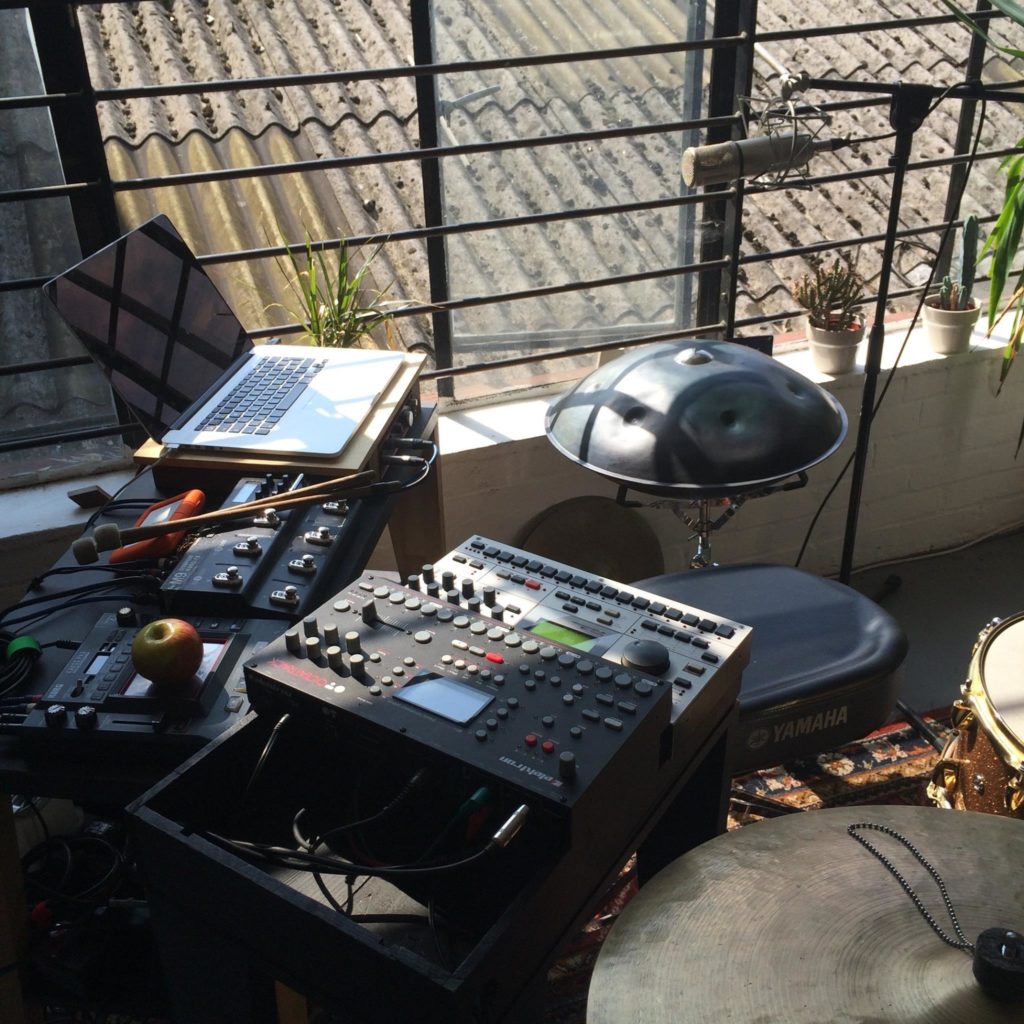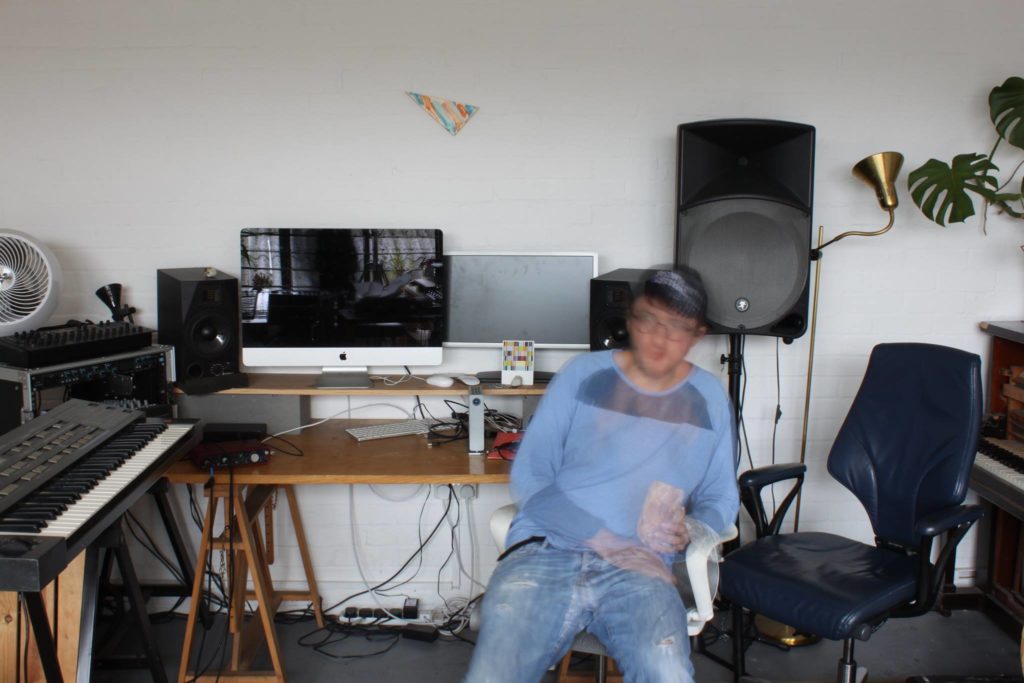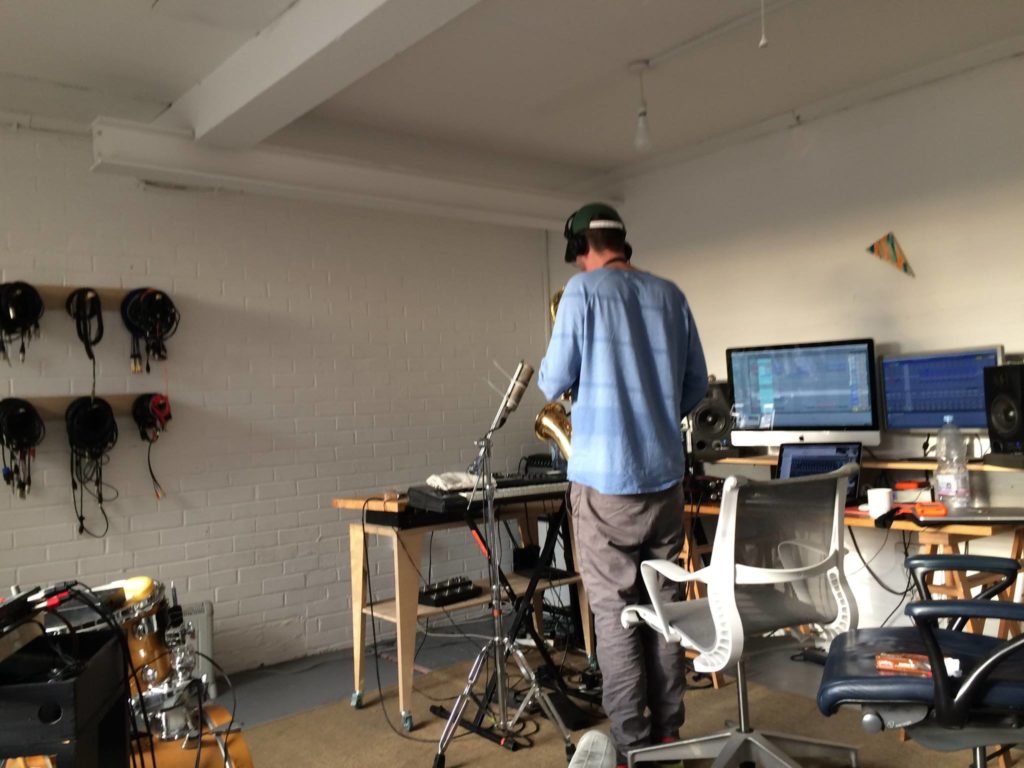
In October, Jack Wyllie released one of 2020’s standout if a little overlooked records. Working with mbalax percussionists Khadim Mbaye and Toms Sambe, the British multi-instrumentalist fused drone, jazz, and tribal drums into eight trance-inducing and propulsive compositions. Together, they comprise Paradise Cinema, an album inspired by Wyllie’s experiences of Senegal, where he relocated to record it. “I wanted to make something that connected to what I experienced in the seven months I was living there,” he explains, “something that was deeply connected to my experience.”
Wyllie grew up in Southampton, on England’s south coast, and learned music through his mother and father, who played the piano and guitar respectively. Aged 13, he began playing saxophone and he involved himself in various indie rock bands with his friends. The turning point came when he moved to London for university, where he met the other members of Portico Quartet, an experimental ensemble brought together in 2005. Three of the four made a name for themselves by busking outside the National Theatre on London’s Southbank, and they’ve since added a new member and compiled a healthy discography of forward-thinking, wide-screen jazz drawing on minimalism and electronic music. Alongside Luke Abbott and Laurence Pike, Wyllie also forms Szun Waves, an experimental jazz project rooted in improvisation. They released their second album, New Hymn To Freedom, in 2018.
In this edition of Artist Tips, Wyllie draws on his decade as a recording artist to outline a number of key practices that have come to define his work. Four of these are focused on listening—essentially creating distance from your music to allow you to develop it more efficiently and effectively—and the final tip considers how you can develop your toolkit to realize your ideas more readily. Each tip is easy to apply, so dig in and learn from one of the UK’s most progressive modern artists.
One of the most difficult things I find when making and producing music is separating myself from the music and hearing it as “objectively” as possible, almost as if I’m listening to it for the first time. For me, this “objective” listening is about being able to gain a clearer picture of what you’re making. I find it’s almost impossible for me to fairly or accurately assess what I’m working on when I’ve been listening to it over and over again, and I start to lose track of what I liked or didn’t like about something. This prevents me from making quick, robust decisions; I actually begin to doubt myself. It’s like I become so accustomed to the sound that I can no longer see the trees through the wood.
With representative visual art, there’s a well-known technique of looking at it in a mirror, which allows you to suddenly see what’s out of place, and if the proportions are wrong, etc. I’m not aware of anything that works quite as well for music, but I’ve found a few techniques that I feel come close. I’m going to outline a handful of them that I use on a regular basis. These are not specific to any genre, but I’ve written about them in relation to producing and composing the album Paradise Cinema, which I made in Dakar, Senegal with percussionists Khadim Mbaye and Tons Sambe over a period of six months.

Maintain Distance by Moving Between Tracks
I’ve learned that it’s important to manage my workflow and move quickly between projects. When I’m working on an album, I’ll limit myself to only a day, or two maximum, getting a draft track together, and moreover I’ll aim to complete 10 draft tracks over the course of a month or so. From that point onwards, I’ll work on each track for a half-day and I’ll keep them circling around. This ensures I have a decent break between working on each track.
“Essentially, it’s about keeping as much distance from each track as possible, and sometimes as an artist you have to create that distance.”
— Jack Wyllie
This really helps because each time you come back to a project that you haven’t worked on in a while you can hear it much more objectively, and this allows me to make faster decisions about whether I like the track or not; I can hear the inconsistencies much more easily. Essentially, it’s about keeping as much distance from each track as possible, and sometimes as an artist you have to create that distance. I use this technique until all the music has been composed and I can trust that I like it. Towards the end, I’ll spend longer on each tune, re-recording and mixing, going really deep into each one, and at this point it’s important that I don’t swap between tracks as often.
To give an example: when I was making the Paradise Cinema record, which ended up being seven tracks, I started by sketching 20 or so tunes over two months. I spent no more than a couple of days on each tune, and I wasn’t too concerned with them being the best thing in the world; I was more focused on getting a core vibe across. Then when I came back to the first thing I worked on, I could instantly tell if I liked it or not. I ditched about half of these sketches at this point, and I moved forward with the others because I thought they had enough to be expanded out into full tracks.
Through this, you can distill your work down to half of what it would have been had you just kept working on each track individually, and it can really help speed up your decision making! This technique is really easy to apply once you’re aware of it, but you have to be disciplined enough to step away from a project when you’re inside it.


Switch Your Environment For New Perspective
I think it’s extremely important to listen to my sketches in different environments. This can be as easy as taking your recordings and standing in a different room, or listening to them in the car when you’re driving, or through headphones on the train or bus. Something about this allows me to spot things that I wouldn’t spot in the studio; it’s like reading a document on a mobile device instead of a computer.
I also like to have the music just loud enough to be able to hear it. This helps me get an overall sense of the tone and feel of the tune. Because you can’t hear the intricacies anymore, you’re less concerned with the small details and I find it helps to make sense of how it makes you feel about the overall picture. Of course, you still need to go back and listen in more detail but if I like the vibe of it, it gives me more confidence to continue working on it.
Apply Your Sketches to Picture
Another more curious thing that has helped me is playing my music while watching a video, although you have to find the right visual! For some strange reason, something about being visually stimulated helps me to detach from the music, and I begin to notice different things instead of assessing every detail.
This is easy to do.
For the Paradise Cinema record, I played my music to slow motion contemporary dance and Koyaanisqatsi, which is a good all-rounder. I take a little break from the music beforehand and then pull up a YouTube video, put it on full screen and silent, and I have my DAW running the tune in the background. I find this works best when you’re nearing completion of the tracks. It’s a great way to just detach from the music a bit and take it all in in its entirety.

Watch Trusted Friends Listen to Your Music
I also try to play my music to friends before I release any of it, but only to people I trust, and not just for their thoughts. For some strange reason, I’ve kept a lot of my music to myself for a long time and it’s only more recently that I’ve come to realise that I can learn so much from watching other people listen to it.
This is a great resource. Because when it’s no longer just me and the music, I react to it very differently, almost as if I’m imagining I’m the other person hearing it. It’s strange. I must say that in these moments I can also become very critical of it, but I think this ultimately really helps, and you should be wary of this.
Speaking of Paradise Cinema, I remember playing some early tracks to friends and I really got the sense that they went on for way too long; it became clear that they just didn’t work at their current lengths. I had the idea of having them at around the 10-minute mark to mirror the hypnotic effect of hearing some of the saba drums in their traditional context, but my friends just weren’t engaging in the way I hoped they would at this length. This music couldn’t hold their attention for that long; or to put it another way, it didn’t have the same hypnotic effect as it can do when played live. So I cut the tracks down and began to focus on shifts in tone.
I also played it alot to my good friend Will, who even helped out with some of the mixes. Simply having that other pair of ears on it to let you know you’re not going mad can be so helpful and encouraging, and it can even challenge you to take it in a different direction.
“…it’s easy to become caught up in trying to be creative all the time, and while that’s great, there’s also craft in being able to fully realize these ideas.”
— Jack Wyllie
“Cover” Tracks to Develop Your Skills
I’d like to finish this feature by looking more broadly at how to “practice” composition and production. I think it’s easy to become caught up in trying to be creative all the time, and while that’s great, there’s also craft in being able to fully realize these ideas. I think this part is often overlooked, and it must be practiced and honed separately from your creative side. One of the great ways to progress the skills I need to be able to execute my ideas is to cover tracks I like.
So if I’m feeling a bit uninspired, I’ll spend time trying to re-create a bit of music I like. If there is a particular sound or style I’m into and want to find out how it works, I’ll find maybe an 8 bar loop and try and work out how it’s working. I’ll basically try to copy it! You learn a lot by really listening to something intensely and working out how to make something sound as similar as possible. You’ll find that your versions always sound a bit different and never as good, but you learn a lot along the way. Importantly, you can draw on that “sound” if you want to use it in something you’re making.
I generally do this with music where the parts are a bit easier to make sense of—because I’m never going to be able to get a proper 12-string guitar sound if I don’t have or can’t play a 12-string guitar! But, for instance, I’ll maybe look at some music with an 808 drum machine as I have decent 808 samples. And then I’ll look at copying the drum parts, looking out for the types of reverb, compression, EQ, etc. I’ll keep A/B ing them until it sounds close. This gives me a better instinct of how to make these types of parts and use these skills in the future.
I often do this when I’m not feeling creatively inspired, or when I’m not trying to answer meaningful personal questions with what I’m doing, which I think can be quite exhausting if you’re trying to make creative, thoughtful music. So in some ways it is just a nice and easy thing to get on with. It’s kind of like practicing scales / patterns on an instrument: you build up familiarity and skills within your craft that can be deployed creatively when needed.
So, as a very basic example, if we take the tune “Visioning Shared Tomorrows” by Kuedo. I can hear it’s essentially an 808. ‘’ll then pull up my 808 from Mars sample, and I then transcribe the drum pattern as MIDI data, then tweak the parameters on the 808, getting the right decay, filter etc. Then I can try and match the effects on them.
I’ll then get a synth that sounds similar, and work out the synth part by playing it on my keyboard. I think the synth is maybe a Prophet 5 or something similar. So I’ll use the soft synth VST from Arturia. You can be pretty loose with these things if you don’t have decent plug-ins. Then I’ll try and match the sound as much as possible and suddenly the track is falling into shape. You can go into as much detail as you want, but you get the picture.
Moreover, it can be especially useful to use these “copies” as jump off points for your own productions. Say, for instance, you like the drum sound: you could look at tweaking it a bit, changing the pattern and a few of the parts to make it sound more like your own, and use it as the basis for a new track!
In a similar way, I was experimenting a lot with effects on the saxophone and ways to play it that referenced Jon Hassell for the Paradise Cinema record. I would transcribe his work and really focus on the tone of the instrument and try to imitate it. He’s a trumpet player so it inevitably sounded quite different. But I also focused on his use of electronics and production with the instrument, taking phrases and playing around with similar ideas to his. I was then able to deploy this when making the album, although I think it sounds quite different as I developed the sound to try and make it my own. You can definitely hear the influence!
Photos by Duncan Bellamy